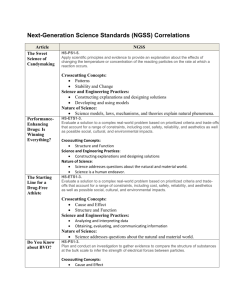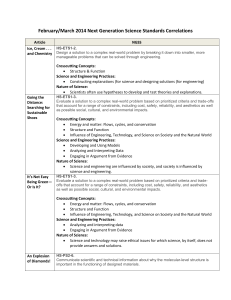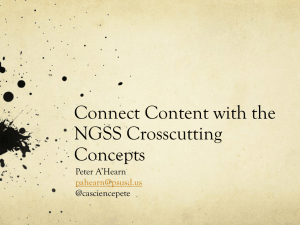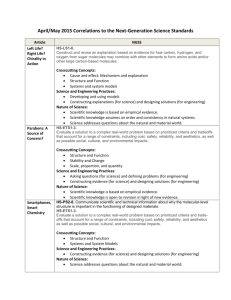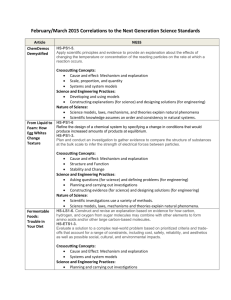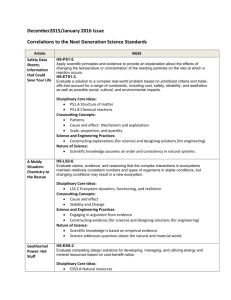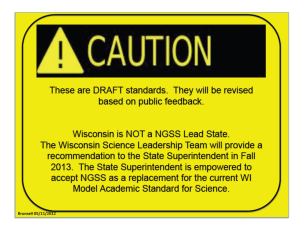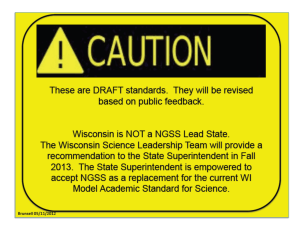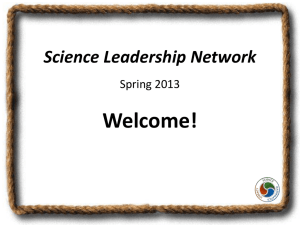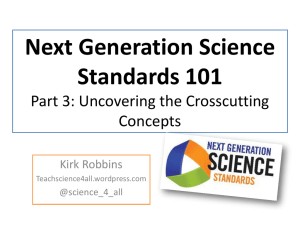Are They Using Crosscutting Concepts
advertisement
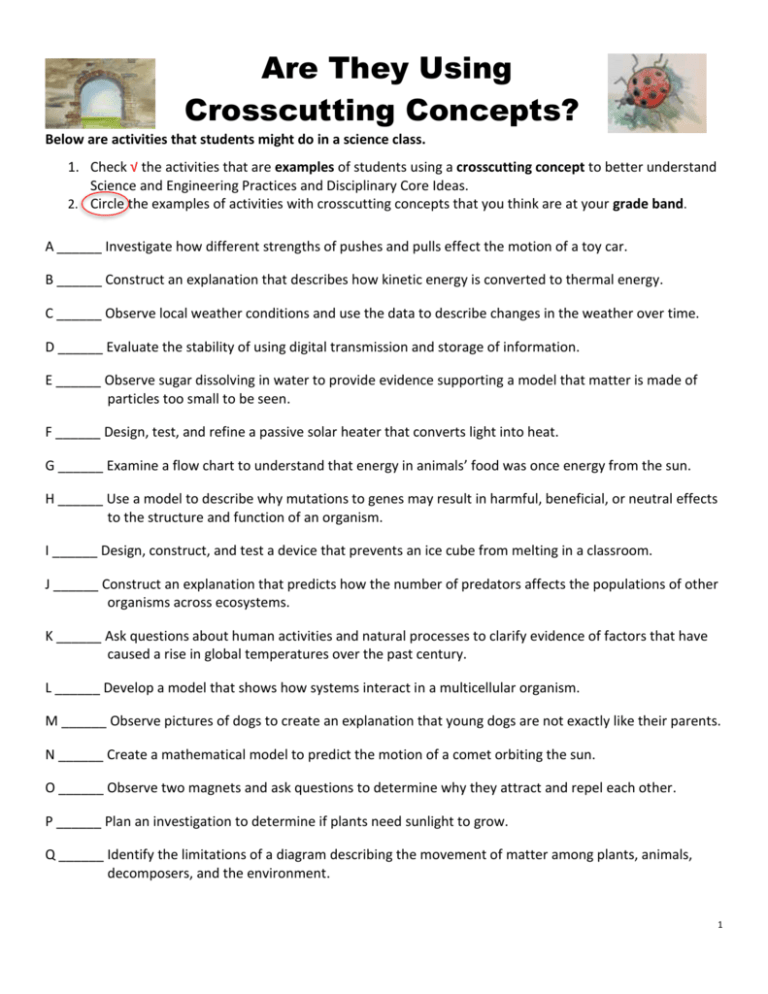
Are They Using Crosscutting Concepts? Below are activities that students might do in a science class. 1. Check √ the activities that are examples of students using a crosscutting concept to better understand Science and Engineering Practices and Disciplinary Core Ideas. 2. Circle the examples of activities with crosscutting concepts that you think are at your grade band. A ______ Investigate how different strengths of pushes and pulls effect the motion of a toy car. B ______ Construct an explanation that describes how kinetic energy is converted to thermal energy. C ______ Observe local weather conditions and use the data to describe changes in the weather over time. D ______ Evaluate the stability of using digital transmission and storage of information. E ______ Observe sugar dissolving in water to provide evidence supporting a model that matter is made of particles too small to be seen. F ______ Design, test, and refine a passive solar heater that converts light into heat. G ______ Examine a flow chart to understand that energy in animals’ food was once energy from the sun. H ______ Use a model to describe why mutations to genes may result in harmful, beneficial, or neutral effects to the structure and function of an organism. I ______ Design, construct, and test a device that prevents an ice cube from melting in a classroom. J ______ Construct an explanation that predicts how the number of predators affects the populations of other organisms across ecosystems. K ______ Ask questions about human activities and natural processes to clarify evidence of factors that have caused a rise in global temperatures over the past century. L ______ Develop a model that shows how systems interact in a multicellular organism. M ______ Observe pictures of dogs to create an explanation that young dogs are not exactly like their parents. N ______ Create a mathematical model to predict the motion of a comet orbiting the sun. O ______ Observe two magnets and ask questions to determine why they attract and repel each other. P ______ Plan an investigation to determine if plants need sunlight to grow. Q ______ Identify the limitations of a diagram describing the movement of matter among plants, animals, decomposers, and the environment. 1 Are They Using Crosscutting Concepts? Teacher Notes The answer is all of the activities are examples of what students do when they use crosscutting concepts to construct understanding of a Disciplinary Core Idea. All of the examples can be linked to NGSS K-12 Performance Expectations Example A B C D E F G H I J K L M N O P Q Linked Performance Expectation Cause and Effect Energy and Matter Patterns Stability and Change Scale, Proportion, and Quantity Energy and Matter Energy and Matter Structure and Function Energy and Matter Patterns Stability and Change Systems and Systems Models Patterns Scale, Proportion, and Quantity Cause and Effect Cause and Effect Systems and Systems Models Examples Grouped by Grade Band A K – PS2-1 C K - ESS2-1 M 1 – LS3-1 P 2 – LS2-1 O 3 – PS2-3 F 4 – PS3-4 E 5 - PS1-1 G 5 - PS3-1 Q 5 - LS2-1 K MS – ESS3-5 I MS – PS3-3 H MS – LS3-1 J MS – LS2-2 L HS – LS1-2 B HS - PS3-2 N HS – ESS1-4 D HS – PS4-2 Crosscutting Concept Cause and Effect Patterns Patterns Cause and Effect Cause and Effect Energy and Matter Scale, Proportion, and Quantity Energy and Matter Systems and Systems Models Stability and Change Energy and Matter Structure and Function Patterns Systems and Systems Models Energy and Matter Scale, Proportion, and Quantity Stability and Change Background Information Crosscutting concepts have value because they provide students with connections and intellectual tools that are related across the differing areas of disciplinary content and can enrich their application of practices and their understanding of core ideas. — Framework p. 233 A Framework for K-12 Science Education identifies seven crosscutting concepts that bridge disciplinary boundaries, uniting core ideas throughout the fields of science and engineering. Their purpose is to help students deepen their understanding of the disciplinary core ideas (pp. 2 and 8), and develop a coherent and scientifically based view of the world (p. 83.) 2 The seven crosscutting concepts presented in Chapter 4 of the Framework are as follows: 1. Patterns. Observed patterns of forms and events guide organization and classification, and they prompt questions about relationships and the factors that influence them. 2. Cause and effect: Mechanism and explanation. Events have causes, sometimes simple, sometimes multifaceted. A major activity of science is investigating and explaining causal relationships and the mechanisms by which they are mediated. Such mechanisms can then be tested across given contexts and used to predict and explain events in new contexts. 3. Scale, proportion, and quantity. In considering phenomena, it is critical to recognize what is relevant at different measures of size, time, and energy and to recognize how changes in scale, proportion, or quantity affect a system’s structure or performance. 4. Systems and system models. Defining the system under study—specifying its boundaries and making explicit a model of that system—provides tools for understanding and testing ideas that are applicable throughout science and engineering. 5. Energy and matter: Flows, cycles, and conservation. Tracking fluxes of energy and matter into, out of, and within systems helps one understand the systems’ possibilities and limitations. 6. Structure and function. The way in which an object or living thing is shaped and its substructure determine many of its properties and functions. 7. Stability and change. For natural and built systems alike, conditions of stability and determinants of rates of change or evolution of a system are critical elements of study. The Framework recommended crosscutting concepts be embedded in the science curriculum beginning in the earliest years of schooling and suggested a number of guiding principles for how they should be used. The development process of the standards provided insights into the crosscutting concepts. Crosscutting Concepts Guiding Principles: 1. Are for all students. 2. Can help students better understand core ideas in science and engineering. 3. Can help students better understand science and engineering practices. 4. Should grow in complexity and sophistication across the grades. 5. Can provide a common vocabulary for science and engineering. 6. Should not be assessed separately from practices or core ideas. 7. Performance expectations focus on some but not all capabilities associated with a crosscutting concept. 8. Repetition in different contexts will be necessary to build familiarity. Adapted from NGSS Appendix G – Crosscutting Concepts, pages 1-3 of 17 3
